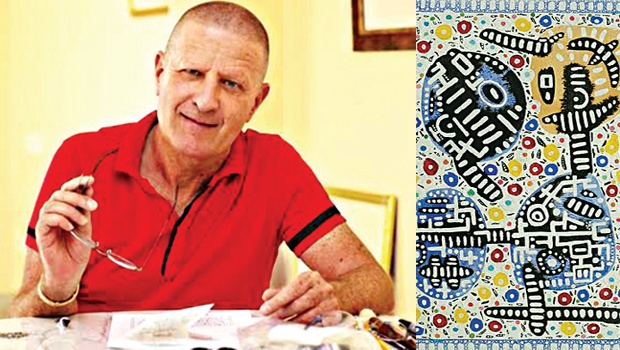Towards the end of the 19th century, Estelle Arpels, the daughter of a dealer in precious stones met Alfred Van Cleef, the son of a stone-cutter and what followed was a great love story and a jewellery design legacy unlike any other. Van Cleef & Arpels is today not just a French brand with a global recall but a space where tradition is unafraid to meet new stimuli and ideas regardless of their source. Where creativity is not just about designing glittering diamond and white gold masterpieces but self-expression. Olaf Van Cleef, the Van Cleef & Arpels scion respects his family legacy but also delves into his rich, inner life and his fascination with India to create paintings that recall aboriginal dot art and pointillism, the foil work and inlaid gems in Thanjavur creations, the water colorists of Shanti Niketan and the gentle staining of tachisme.
Fifty of his works were shown at Gallery-g, Lavelle Road last December.
**
In an interview, Olaf Van Cleef talks about his love for India’s mysticism, the painful persecution of his family and how the emotions of pain and loss can be transfigured through art. Olaf who divides his time between Paris and Puducherry, has also been Cartier’s sales associate and adviser and has worked for over 10 years in Delhi, Mumbai, Bengaluru and Kolkata.
**
He took to painting over a decade ago after chronic insomnia forced him to look within for solace. He was also possibly reminded of 160 Van Cleefs who died in Nazi camps during the second World War and how heroic it must have been to create a legacy of beauty in the face of such tragedy. He says, “I learnt about life by watching my grandmother deal with tragedy. She had lost her husband in the Auschwitz camp. I could have been burdened, infected by terror and religious issues since I saw her fruitlessly await the return of her husband, who never came back. But even then, instead of being bitter, she was immersed in reading and listening to Mozart and Vivaldi’s Four Seasons. I woke up to the same music day after day. That was my lineage.”
**
The world is still scarred by tragedies, he reminds. And says, “How does one deal with that? There is not a week that these tragedies happening across the world do not disturb me. I meditate for hours, I paint (each work takes over 150 to 200 hours) and so life must resume just as my grandmother went on.”
His connection with India dates back to her mother who spent part of her honeymoon in this country and to the time when he came here as a teenager and irrevocably fell in love. He says,” Puducherry has this elegant place, aHotel D’ Europe and it is run by a French person who has never set foot in France! The place has no phone or hot water but an extraordinary veranda with palms, antique furniture, posters of the Palace of Versailles, Mont Saint–Michel alongside sculptures of Shiva and Parvati! Would you believe that this is exactly what I saw in a dream when as a boy of 10, I first read Kipling’s The Jungle Book?“
**
It was fitting then that he held his first art show at Sri Aurobindo Ashram exhibition hall in Puducherry. Later the works travelled to Chennai, Kolkata and the abstraction of thoughts solidified in imagery drawn from Indian mythology. In September 2015, he will be exhibiting paintings based on Bhutanese Buddhist icons in Thimphu, Bhutan.
**
But the love for India is the bedrock of his life and he says, “Both my grandmother and I never considered India like a touristy or exotic place but like home. Very early, India became a reference point for me from where I draw my life lessons. India represents a larger vision of the life, and a respect for tradition. India’s faiths,culture, arts, jewellery traditions impress me a lot and all that reflects in my paintings. India to me is like a mosaic… very intricate with its languages, art, architecture, flowers, animals, colours with several particularities. But my part also refers to European details. For instance, you can see Ganesha in a French style Louis XVI room, a princess can be seen with a typical Cartier necklace and there is Akbar in the French Riviera! When I am in India, my mind travels all the time. I would like the Indians to travel also when they see my paintings.”**
There is a dreamy quality about his work and he says, “In my paintings there are three important things:
The reality where I undertake the representation of the subject, the symbolic subtext with the details around the subject and the element of imagination and dreams. My dreams arrive with gold papers, gems and crystals, the alchemy of different sized stones and colours, the cascade of crystals. You have perhaps more than 3000 years of culture and I bring the past and the future together in my work. Maybe my art will be treated like an antique by the future generation.”
He talks about Thomas Daniell who was an English landscape painter but was drawn to India and published several series of aquatints of the country.
Painters like Daniell, he says, were once just visitors but are now part of India’s artistic heritage. And that is what he hopes to be.
**
 with The New Indian Express
with The New Indian Express
Reema Moudgil works for The New Indian Express, Bangalore, is the author of Perfect Eight, the editor of Chicken Soup for the Soul-Indian Women, an artist, a former RJ and a mother. She dreams of a cottage of her own that opens to a garden and where she can write more books, paint, listen to music and just be.







 with
with